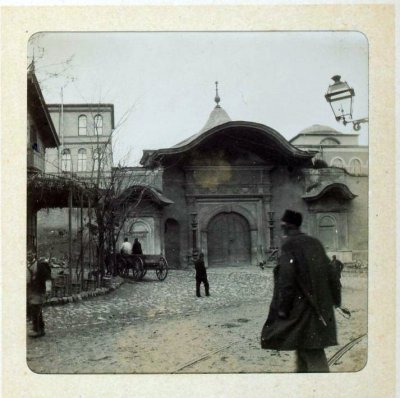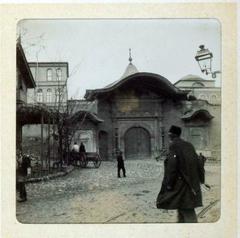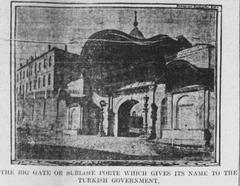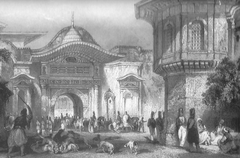
Visiting the Sublime Porte (Bab-ı Âli) in Istanbul: History, Tickets, Hours, and Essential Tips
Date: 14/06/2025
Introduction
The Sublime Porte (Bab-ı Âli) stands as a majestic symbol of Istanbul’s Ottoman legacy, serving for centuries as the nerve center of imperial administration and diplomacy. As the main entrance to the Grand Vizier’s offices, it was synonymous with Ottoman authority and a stage for pivotal moments in world history. Today, its iconic rococo gate, nestled in the heart of the Sultanahmet district, remains a must-see for travelers and history enthusiasts exploring Istanbul’s rich past. This comprehensive guide covers the Sublime Porte’s historical significance, architectural highlights, practical visitor information—including hours, ticketing, accessibility—travel tips, and nearby attractions to ensure a rewarding visit.
For further historical context and visitor tips, consult resources such as World History Edu, Istanbul.tips, and Lonely Planet.
Table of Contents
- What is the Sublime Porte?
- Historical Background
- Architectural Features
- Visiting the Sublime Porte
- Visitor Tips and Cultural Etiquette
- Frequently Asked Questions (FAQ)
- Conclusion and Recommendations
- References
What is the Sublime Porte?
The Sublime Porte, or Bab-ı Âli, was historically the grand gate leading to the offices of the Ottoman Grand Vizier. Much like “Whitehall” in the UK or “the Kremlin” in Russia, it became a metonym for the Ottoman government itself. The name, meaning “High Gate,” reflects its status as the locus of imperial power, where state decisions were made, foreign diplomats were received, and major reforms were declared.
Historical Background
Origins and Architectural Evolution
The Sublime Porte’s origins date to 1478, commissioned under Sultan Mehmed II. Initially called Paşa Kapısı, it became Bab-ı Âli in the 16th century. The present rococo-style gate was built in 1843 after a series of fires, featuring ornate baroque details, a grand arch, and an elegant fountain. Architect Stefan Kalfa incorporated late Ottoman classicism, Empire, and rococo influences to create a structure that projected both authority and sophistication (tr.wikipedia; istanbul.gov.tr).
Political and Diplomatic Significance
For centuries, the Sublime Porte was the heart of Ottoman governance and diplomacy. Here, imperial edicts were proclaimed, foreign ambassadors were received, and landmark treaties negotiated. The 19th-century Tanzimat reforms—proclaiming legal equality and modernizing governance—were announced from these very steps (World History Edu). Even after the Ottoman Empire’s dissolution, the symbolism of the Porte endures in Turkish political culture.
Architectural Features
- Style: Combines late Ottoman classicism, Empire, and rococo elements.
- Key Elements: Monumental gate with baroque cornices, rococo arch, and a ceremonial fountain.
- Layout: Once a sprawling 220-meter complex housing the Grand Vizier’s office, Ministry of Foreign Affairs, and Council of State.
- Reconstruction: Rebuilt after fires in 1839, 1878, and 1911; the central section was not restored after 1911, dividing the complex.
- Function Today: The Istanbul Governor’s Office now occupies the site (istanbul.gov.tr).
Visiting the Sublime Porte
Location and Accessibility
- Address: Bab-ı Ali Caddesi No:28, Fatih, Istanbul.
- District: Sultanahmet, at the heart of the city’s UNESCO-listed historic peninsula.
- Public Transport: Accessible via the T1 tram (Sultanahmet stop), bus, or taxi. The area is pedestrian-friendly but includes cobblestone streets; suitable footwear is recommended.
- Accessibility: Most of the area is walkable, though uneven surfaces may present challenges to those with mobility concerns.
Visiting Hours and Tickets
- Exterior Viewing: Open year-round, 24/7, as part of the public urban landscape.
- Interior Access: Not open to the general public; the building serves as the Istanbul Governor’s Office.
- Entrance Fee: None for viewing the exterior. Adjacent attractions, such as Topkapı Palace and Hagia Sophia, require tickets.
- Nearby Museum Pass: Consider the Istanbul Museum Pass for discounted and expedited entry to major sites.
Guided Tours and Nearby Attractions
- Tours: Many walking tours of Sultanahmet include the Sublime Porte’s exterior, providing historical context.
- Landmarks Within Walking Distance:
- Topkapı Palace – 500 meters east.
- Hagia Sophia – 400 meters away.
- Blue Mosque – 300 meters away.
- Grand Bazaar and Basilica Cistern also nearby.
Photography Tips
- Best Times: Early morning or late afternoon for optimal light and fewer crowds.
- Angles: Capture the gate and fountain from Alemdar Caddesi; wide-angle lenses work well.
- Alt Tags: Use descriptive alt text (e.g., “Sublime Porte gate in Istanbul, historic Ottoman government building”) for SEO optimization.
Visitor Tips and Cultural Etiquette
- Dress Code: Modest attire is suggested due to proximity to religious sites.
- Behavior: Respect the area’s historical significance; photography is welcome outside.
- Best Times to Visit: Spring and autumn offer pleasant weather and thinner crowds.
- Safety: Sultanahmet is generally safe, but remain alert for pickpockets and unsolicited vendors.
- Amenities: Numerous cafés, restrooms in major attractions, and hotels nearby.
- Accessibility: Some historic streets are uneven; plan ahead if you have mobility needs.
Frequently Asked Questions (FAQ)
Q: Is the Sublime Porte open to the public?
A: The gate and exterior are accessible at all times, but the interior is not open for tours.
Q: Is there an entrance fee?
A: No, viewing the Sublime Porte’s exterior is free.
Q: Can I join a guided tour?
A: Yes, many Sultanahmet walking tours include the Sublime Porte as a stop.
Q: How do I reach the Sublime Porte?
A: Take the T1 tram to Sultanahmet, then walk a few minutes to Bab-ı Ali Caddesi.
Q: Is the area wheelchair accessible?
A: The district is mostly accessible, but some surfaces are uneven.
Q: Where can I buy tickets for nearby attractions?
A: On-site or online; the Istanbul Museum Pass is recommended for multiple sites.
Conclusion and Recommendations
The Sublime Porte is a cornerstone of Istanbul’s Ottoman heritage, offering an evocative glimpse into the city’s centuries-old role as a center of governance and diplomacy. While its interiors remain off-limits due to its governmental function, the imposing gate and surrounding Sultanahmet district provide a rich context for exploration, photography, and learning. Combine your visit with stops at Topkapı Palace, Hagia Sophia, and the Blue Mosque for a comprehensive immersion in Istanbul’s imperial and religious history. For the best experience, plan your visit during quieter hours, dress appropriately, and consider joining a guided tour. Leverage resources like the Audiala app for the latest tips, maps, and updates.
References
- Brief History of Istanbul and Its Most Famous Historical Sites – World History Edu
- Dos and Don’ts in Istanbul, Turkey: A Comprehensive Guide for Tourists – Istanbul.tips
- Sublime Porte (Bab-ı Âli) – Lonely Planet
- Bâb-ı Âli – Turkish Wikipedia
- Babiali History – Istanbul Governorate
- Sublime Porte – Britannica
























































































































